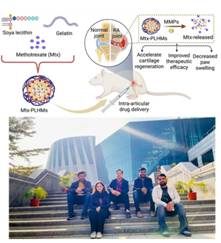Rheumatoid arthritis (RA) is a chronic autoimmune disorder characterized by joint inflammation and painful deformities, profoundly impacting the quality of life for millions worldwide. Conventional treatment modalities primarily rely on systemic administration of non-steroidal anti-inflammatory drugs (NSAIDs), glucocorticoids, and disease-modifying antirheumatic drugs (DMARDs). However, these therapies often lead to adverse effects and variable patient responses, underscoring the need for more effective and targeted approaches. Innovative drug delivery systems hold the potential to revolutionize the management of RA by enhancing therapeutic efficacy and minimizing side effects.
Emerging drug delivery technologies, such as nanocarriers, microspheres, and hydrogels, facilitate localized drug administration and controlled release. These systems can encapsulate anti-inflammatory agents and biologics, thereby providing sustained therapeutic levels directly at the site of inflammation. For instance, nanoparticles can improve the bioavailability of poorly soluble drugs and promote cellular uptake, ensuring that higher concentrations of medication reach affected joints. This targeted approach not only enhances treatment efficacy but also mitigates systemic exposure, thereby reducing the risk of side effects commonly associated with traditional therapies.
Moreover, innovative delivery systems can be engineered to respond to specific biological stimuli. Smart drug delivery systems, such as stimuli-responsive nanocarriers, can release their payload in response to changes in the local microenvironment, such as pH or temperature fluctuations in inflamed tissues. This adaptability ensures that therapeutic interventions are precisely timed and tailored to the needs of the patient, thereby optimizing treatment outcomes.
Furthermore, patient-centric approaches, such as transdermal patches and implantable devices, can significantly improve adherence to treatment regimens. By providing a non-invasive means of drug administration, these innovative systems may alleviate some psychological and logistical barriers faced by patients with RA, such as fear of injections or the complexity of oral dosing schedules.
